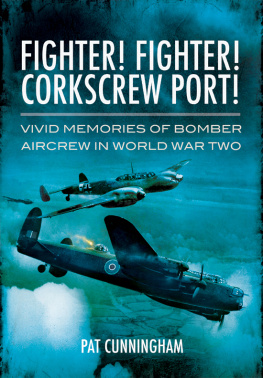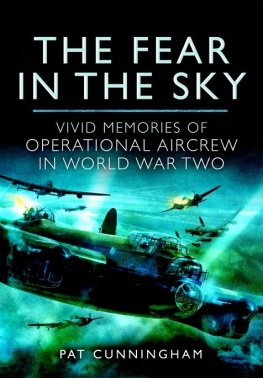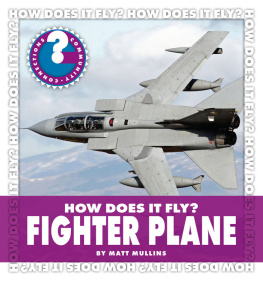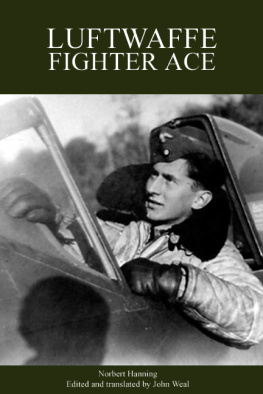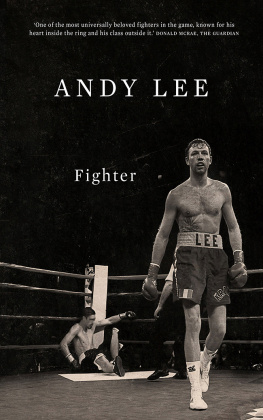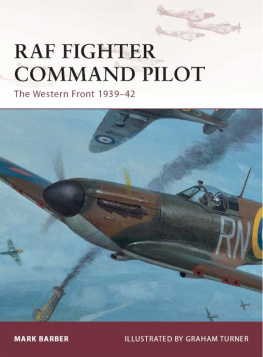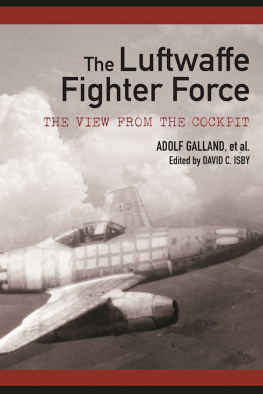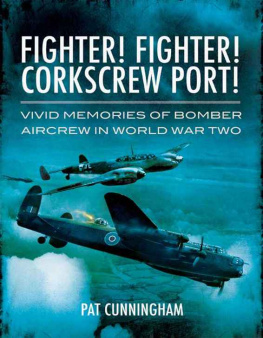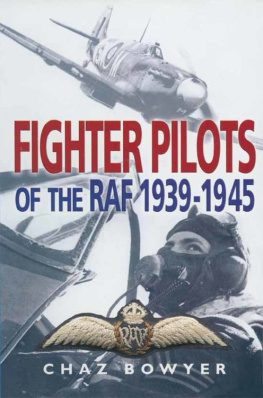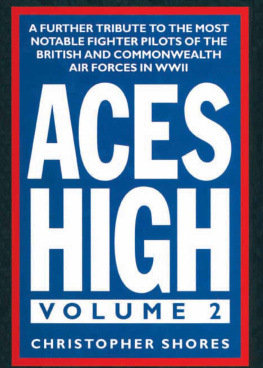Pat Cunningham - Fighter! Fighter! Corkscrew Port!
Here you can read online Pat Cunningham - Fighter! Fighter! Corkscrew Port! full text of the book (entire story) in english for free. Download pdf and epub, get meaning, cover and reviews about this ebook. publisher: Pen & Sword Aviation, genre: Non-fiction. Description of the work, (preface) as well as reviews are available. Best literature library LitArk.com created for fans of good reading and offers a wide selection of genres:
Romance novel
Science fiction
Adventure
Detective
Science
History
Home and family
Prose
Art
Politics
Computer
Non-fiction
Religion
Business
Children
Humor
Choose a favorite category and find really read worthwhile books. Enjoy immersion in the world of imagination, feel the emotions of the characters or learn something new for yourself, make an fascinating discovery.
- Book:Fighter! Fighter! Corkscrew Port!
- Author:
- Publisher:Pen & Sword Aviation
- Genre:
- Rating:4 / 5
- Favourites:Add to favourites
- Your mark:
- 80
- 1
- 2
- 3
- 4
- 5
Fighter! Fighter! Corkscrew Port!: summary, description and annotation
We offer to read an annotation, description, summary or preface (depends on what the author of the book "Fighter! Fighter! Corkscrew Port!" wrote himself). If you haven't found the necessary information about the book — write in the comments, we will try to find it.
Fighter! Fighter! Corkscrew Port! — read online for free the complete book (whole text) full work
Below is the text of the book, divided by pages. System saving the place of the last page read, allows you to conveniently read the book "Fighter! Fighter! Corkscrew Port!" online for free, without having to search again every time where you left off. Put a bookmark, and you can go to the page where you finished reading at any time.
Font size:
Interval:
Bookmark:

Other Books by the Author
Non-fiction
Peakland Aircrashes Series:
The South (2005)
The Central Area (2006)
The North (2006)
High Peak Air Crash Sites, Central Region
White Peak Air Crash Sites
Bomb on the Red Markers
Faction
A Magnificent Diversion Series (Acclaimed by the First World War Aviation Historical Society)
The Infinite Reaches 191516
Contact Patrol 1916
Sold A Pup 1917
The Great Disservice 1918
Blind Faith: Joan Waste, Derbys Martyr
Joyce Lewis of Mancetter, Lichfields feisty Martyr
Fiction
In Kinders Mists (a Kinderscout ghost story),
Though the Treason Pleases (Irish Troubles),
First published in Great Britain in 2012 by
PEN & SWORD AVIATION
An imprint of
Pen & Sword Books Ltd
47 Church Street
Barnsley
South Yorkshire
S70 2AS
Copyright Pat Cunningham 2012
ISBN 978 1 84884 655 5
Digital Edition ISBN: 978 1 78346 147 9
The right of Pat Cunningham to be identified as Author of this work has been
asserted by him in accordance with the Copyright, Designs and Patents Act 1988.
A CIP catalogue record for this book is available from the British Library
All rights reserved. No part of this book may bereproduced or transmitted
in any form or by any means, electronic or mechanical including photocopying,
recording or by any information storage and retrieval system,
without permission from the Publisher in writing.
Pen & Sword Books Ltd incorporates the Imprints of Pen & Sword Aviation,
Pen & Sword Family History, Pen & Sword Maritime, Pen & Sword Military,
Pen & Sword Discovery, Wharncliffe Local History, Wharncliffe True Crime,
Wharncliffe Transport, Pen & Sword Select, Pen & Sword Military Classics,
Leo Cooper, The Praetorian Press, Remember When, Seaforth Publishing
and Frontline Publishing
Printing in England by Anthony Rowe UK.
For a complete list of Pen & Sword titles please contact
PEN & SWORD BOOKS LIMITED
47 Church Street, Barnsley, South Yorkshire, S70 2AS,England
E-mail:
Website: www.pen-and-sword.co.uk.
To the traced copyright holders for authorizing the use of their photographs: Richard Haigh, manager, intellectual properties, Rolls-Royce; Nicola Hunt, intellectual property rights copyright unit, MOD; archives staff, Imperial War Museum; Judy Nokes, licensing adviser, HMSO (Crown Copyright/MOD); archives staff, Royal Air Force Museum.
Craving the indulgence of those for whom all contact attempts have failed.
To Julian Temple and John Lattimore, of Brooklands Museum for their Wellington expertise.
To Clive Teale, aviator and grammarian, for technical advice. Similarly to Ken Johnson and Ken Clare for down-to-earth criticism.
To the photographic staff at ASDA, Spondon, who, if irreverent, gave unstinting assistance; similarly, to the staff at the co-located McDonalds, for sustenance.
To the Chief Executive of Derwent Living, winter 2010 - 2011 (the coldest in 100 years): for no central heating, and memorable proofreading of four books in fingerless gloves.
Despite such inestimable assistance, any errors remaining, and all opinions expressed, are my own.
Pat Cunningham, DFM
This book is a tribute to the Second World War aircrews of the Royal Air Force who, for much of that conflict, were Britains only direct means of striking back at the enemy. And yet until a short time before the outbreak of war the RAFs concept of aircrew was hazy to say the least, indeed, the term itself did not gain currency until 1939. Fortunately, in 1934 perceptive elements in the government authorized a massive expansion of the RAF. However, as an unlooked-for outcome this also showed up serious shortcomings.
Paramount among these was the lack of a cohesive policy for the crewing of aircraft, and particularly of the heavy bombers which, even then, were long past the drawing-board stage. Essentially, the system regarded only pilots as full-time fliers. The others, observers and air gunners, were invariably found among volunteer tradesmen whose technical qualifications were rather wastefully misemployed when they were called from the workshops to fly.
There was also the woeful state of navigation, illustrated by the fact that in a two-year period 478 RAF bombers made forced-landings because their pilots had lost their way. And that was over Britain, when venturing aloft at night, over a fully-lit land!
Steps taken to rectify matters included sending all observers on ten-week navigation courses. Even so, just two months before the outbreak of war the Commander in Chief of Bomber Command, Air Chief Marshal Ludlow-Hewitt, was obliged to report to the Air Council that his command was incapable of operating in anything but fair weather.
In the interim air gunners and observers had been established as full-time fliers and, nominally, at least, made sergeants, although this would take time to implement. Even so, the gunners were expected to double as wireless operators, and the observers as bomb aimers. Clearly, to fully crew the anticipated heavy bombers would be an enormous undertaking calling for the economic husbanding of resources.
The requirements decided upon for these yet-to-be-found fliers were not particularly flattering. The medically suitable aspirant volunteer, while not exceptional, was to be more than keen to learn. A mechanical background would be advantageous and he should have a good general education with a fair working knowledge of maths and the application of simple formulae. It was to be left to the Initial Training Wing (ITW) to bring out the dormant spirit of aggression and to maintain personal initiative while encouraging the crew spirit.
Meanwhile, the creation of instant sergeants did not sit happily with the non-fliers in a Service where promotion had been historically slow. But the new planners were also stuck with another historical precedent, that of commissioned and non-commissioned fliers that had been foisted upon the Service since the earliest days. In 1914 Trenchard the revered Father of the RAF had seen no need to commission pilots, reasoning that they commanded nobody and that the trained military observer they carried would regulate the sortie. The Royal Naval Air Service, however, offered commissions to its pilots, so that, suddenly facing a dearth of recruits, the Royal Flying Corps had to follow suit.
As the Second World War loomed then, the attributes of aspirant aircrew had been established. But where were these not exceptional volunteers to be found?
Happily, the climate was right. Race-awareness of four years of Flanders mud and blood had raised the sights of many to the knightly conflict fought by the air aces of that Great War. In addition, the aerial record breakers were rarely out of the headlines. And always there was the allure of Flight, mankinds primeval dream. Finally, after war actually broke out, German blitzes and the desire to strike back became a spur for so many more that, in the event, recruiting aircrew was always to be a matter of feast rather than famine.
Where flying training was concerned, however, the British weather presented enormous problems to continuity. These, though, were alleviated through schemes by which such training could be done in the fair-weather skies of not only Commonwealth countries but of the still-neutral United States. Notwithstanding, it would still take nearly two years to bring many aircrew to an operationally-ready state.
Font size:
Interval:
Bookmark:
Similar books «Fighter! Fighter! Corkscrew Port!»
Look at similar books to Fighter! Fighter! Corkscrew Port!. We have selected literature similar in name and meaning in the hope of providing readers with more options to find new, interesting, not yet read works.
Discussion, reviews of the book Fighter! Fighter! Corkscrew Port! and just readers' own opinions. Leave your comments, write what you think about the work, its meaning or the main characters. Specify what exactly you liked and what you didn't like, and why you think so.

